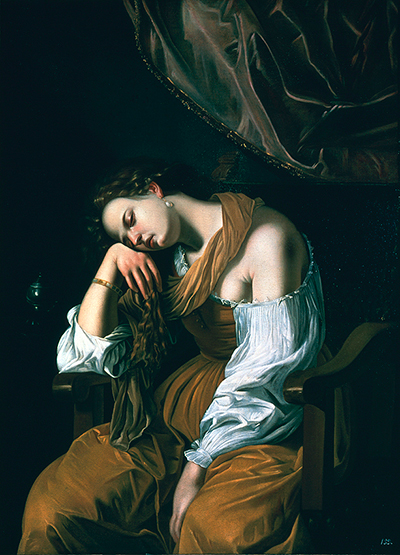Mary Magdalene as Melancholy is a canvas painting created in 1622-1625 by Artemisia Gentileschi. It shows Mary Magdalene or simply Madeleine as a personification of a mental disorder called Melancholia.
In this depiction of Magdalene, Artemisia Gentileschi – who was raped by a workmate of her father in 1611 at the age of 17- may have been conveying her own inner state. She has a stylised nose, a rounded face, and reddened eyes, which are super tired from crying. Her pose of giving up legitimises her letting go of rank or decorum in favour of suffering of the loss of Christ, and her face attempts to find consolation on her weak hand. On the side, there is a perfume bottle that is characteristic of Saint Mary of Bethany; Its importance is mistakenly associated with Magdalene for the anointing of the feet of Jesus Christ.
Guillermo Tovar de Teresa, a researcher, saw the crease between the armpit and arm of the protagonist as an allusion of sexual intercourse. The great piece is now in Soumaya Museum in Mexico City, and it bears a resemblance with ‘Penitent Magdalene’ now in the Treasury of Seville Cathedral in Spain. An Xray examination showed that that the fabric on the shoulders of the saint is a little wider in the Cathedral of Seville version; it was possibly added later in order to fit with the Catholic Church’s canons. The Xray also demonstrated that the faces are a bit different. In essence, there are corrections in the brushstrokes in the Cathedral of Seville version and the Mexico City version is a self-painting by comparison with Cleopatra and Judith Slaying Holofernes.
All in all, both pieces, Mary Magdalene as Melancholy and Penitent Magdalene, are good examples of the Baroque chiaroscuro technique that echo Caravaggio work. The painter developed her excellent artistic skills with the help of her talented father, Orazio, who was influenced by Caravaggio. Her Baroque work were some of the most dynamic and dramatic of her generation. So, she became well-known for her realism, her masterly used of chiaroscuro, and also for placing ladies and their incredible stories at the centre of her images. Other popular works by this Italian painter include Madonna and Child, Judith Slaying Holofernes, and Susanna and the Elders.




